Auckland, the biggest city in New Zealand is still a young city with less than 200 years of history since the european settlement when they made truces with the indigenous Māori. Within the short history of the city, every night in the last 70 years, when nights fall, the true Aucklanders gather at the white lady – the iconic pie-cart of new zealand. This pie-cart is the salient icon of street food culture of this island country.
[rpi]
HOW DID I FALL IN LOVE WITH THE WHITE LADY
Just like many generations of Aucklanders, I have fallen in love with her, The White Lady at first “bite”. I first discovered the pie-cart on a summer’s night two years ago when the breezing wind from the Haruki Gulf was wandering through many of Auckland’s silent streets. Despite the fact that Auckland is the biggest city in New Zealand where hundreds of bars and restaurants are operating through the night, its nightlife is nothing compared to New York’s, or only to Melbourne’s – its neighbour from across the Tasman Sea. That night, the city came into its peaceful silence albeit the supposed festive summer’s vibe. I was having my walk at a late hour along the harbour where the waves gently laps the docks. Turning to Commerce Street, a big white mobile and its warm light caught my eyes. Along the pavements, there was a group of people purchasing burgers from the white mobile. Some were leaning against the building’s wall; some were sitting on plastic milk racks turned upside down to make casual stools. Some were chatting; the others were silently enjoying their delicious supper.
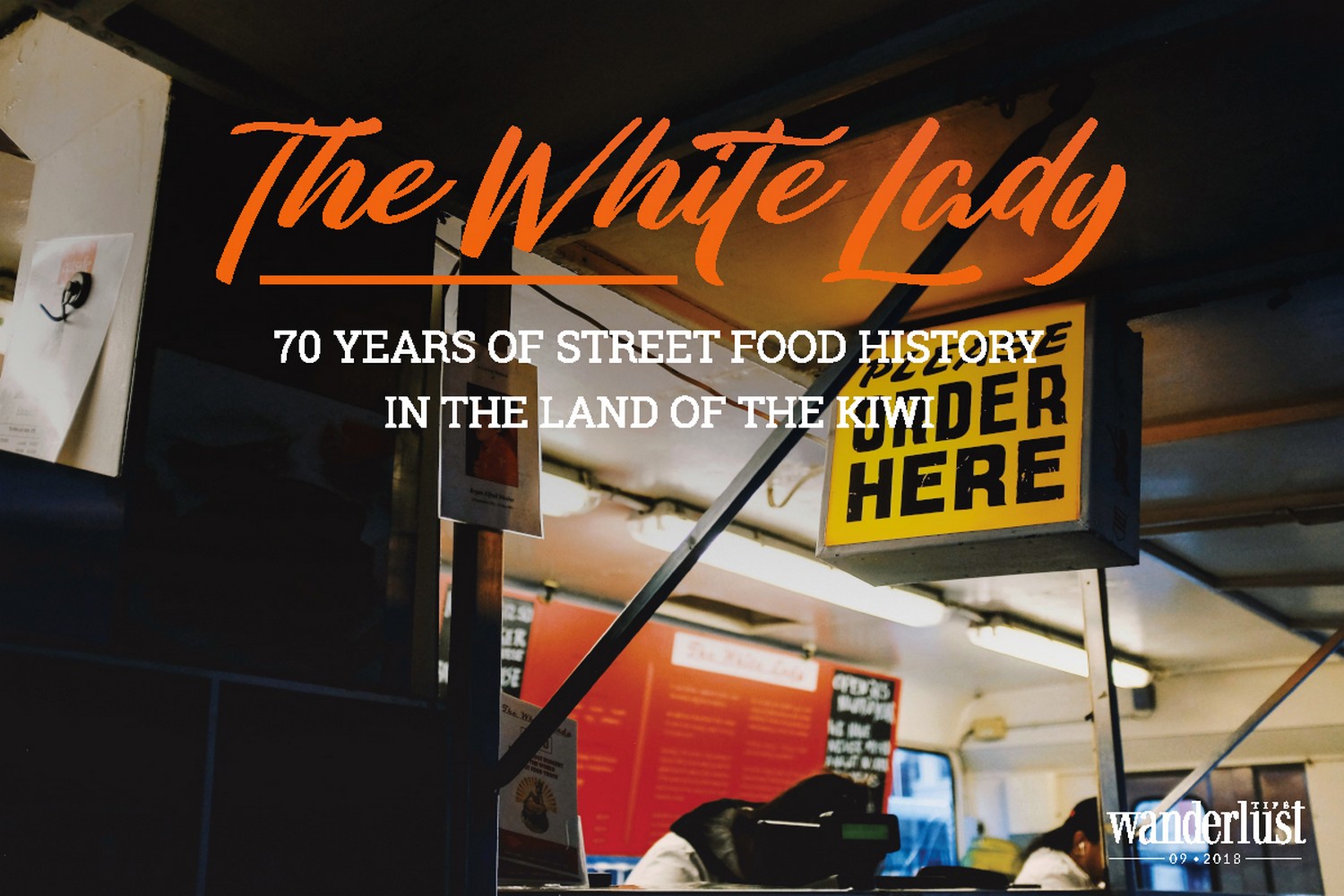
Intrigued by the vibe, I went and bought myself a burger. The White Lady didn’t disappoint me. No pale and squishy sandwich from any of the fast food chains which were only a few hundred metres away from the spot could compare to the burger I had that night. Between two freshly toasted pieces of bun were layers of green crunchy veggies, a juicy beef patty, soft fried egg with a crispy base, and melted Colby cheese. Who would have known that when night fell, at this very corner, there was a street food vendor that could make burgers taste like heaven?
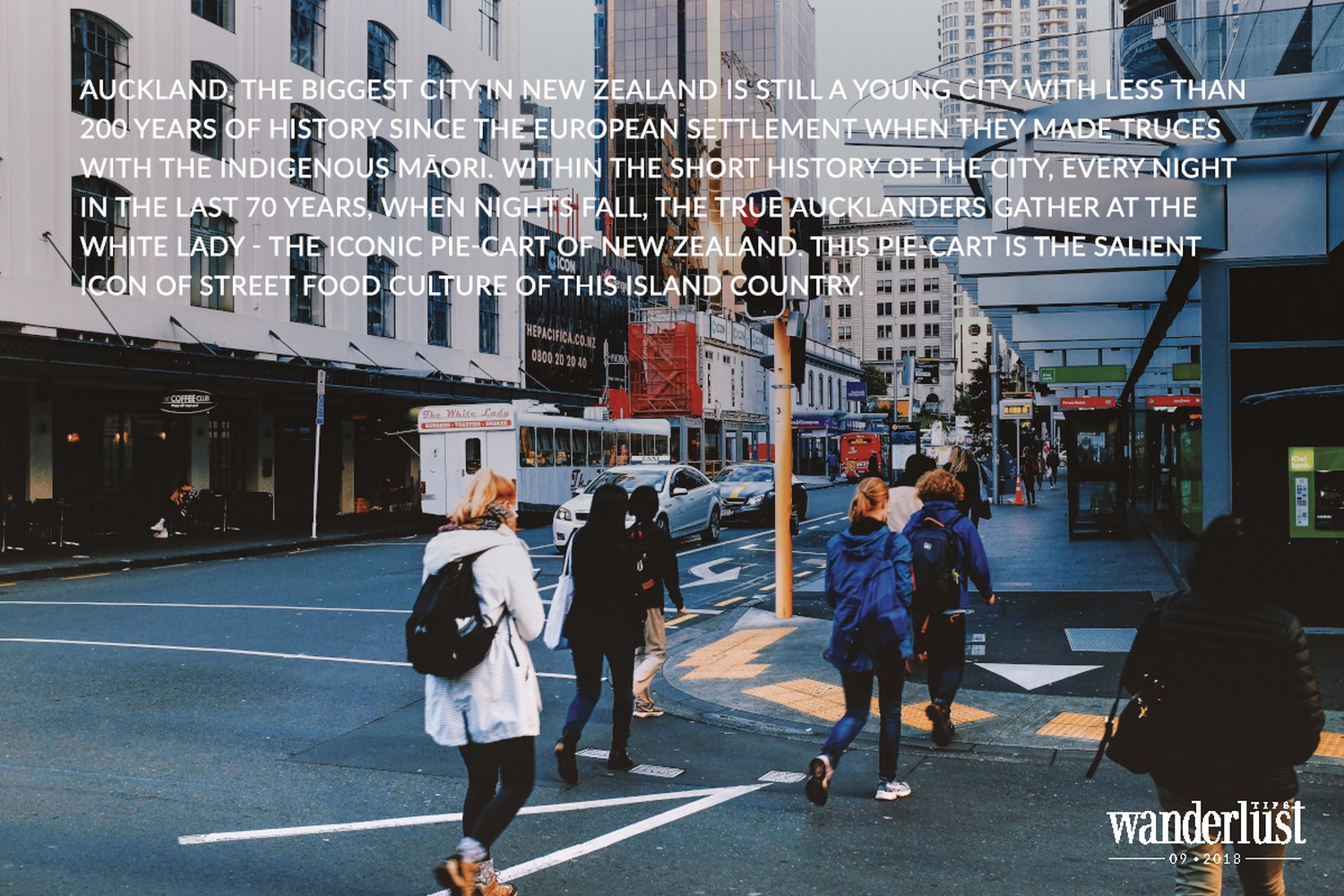
To an Asian, street food means those small stalls or mobile carts that always move all over town. However, street food can also mean different things. It can be those fish and chips vendors in Great Britain. It can also be the hot dog carts found at many corners in the East Coast of the States. Here, in New Zealand, it is the pie-carts which entail many fascinating stories of how they came and have been developed during all those years.
There was a time when pie-carts like The White Lady were the centre of every town and city in New Zealand. Foreigners usually mistake it with an American food truck, but here, mobile food vendors like The White Lady are called pie-carts. An American food truck is normally an innovative mini-truck, whereas a pie-cart is more like a caravan which is carried by a stand-alone engine.
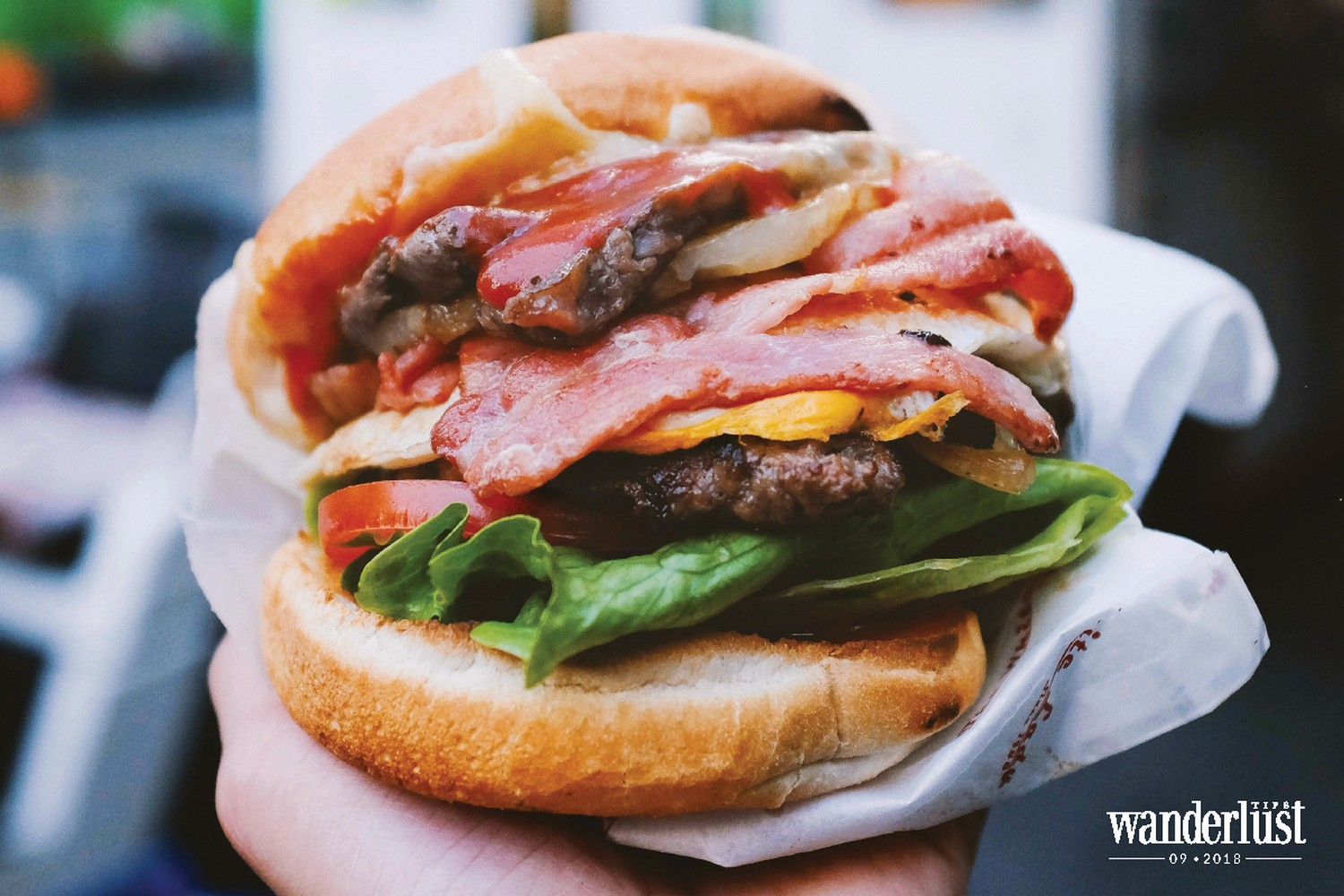
New Zealand’s pie cart first appeared during the Great Depression in the 1930s. Pie-cart culture was blooming during the afterwar era. In the first half of the 20th century, Auckland was still very much isolated due to its geographical location, as well as the constraint of intercontinental travelling at the time. In the city, the Depression was consuming everything, including the city’s lifestyle. All streets were lined with gravel; no vehicles could travel fast; and electricity was a luxury. During this dark era of the modern time, New Zealand’s pie carts became the spotlight of every town. They often parked in front of the town’s post office and were selling coffee, along with the working-class’s legendary food trio which gave the pie-cart its name, “pea, pie, pud” (pud was the word used for mashed potato). Pie-carts become the icon of New Zealand’s street food culture, but also of people who grew up in he 1940s and 1950s. Everybody back then had been to one of their local pie carts for a quick bite during the day.
However, there is nothing that lasts forever. As time changes, New Zealand’s pie-carts have been dying out. After the second world war, many of the workingclass’s icons like the pie-cart started to disappear. Air travel had brought people from around the globe to this little country at the rear of the world, while those people had also brought new and exotic culinary cultures and trends into New Zealand. The younger generations have been consuming the newer versions of food and dining cultures day after day ever since. On the other hand, the government has started cracking down many issues related to food hygiene and waste management of food premises. Only a few pie-carts are still operating in every town across the country. And the most remarkable of them all is The White Lady, the oldest pie cart of New Zealand which has survived since the afterwar era till the 21st century.
70-YEAR HISTORY OF THE WHITE LADY
The White Lady started to operate in 1948 and is owned by the Washer family. The founder of it was Brian Washer (also known as ‘Pop’). Before The White Lady, Pop, like many of his generation, had deeply embraced the youth culture of his time which included rugby games, racing tracks, and beers. After some time spent at a detoxication centre, Pop ran a beverage caravan at the race tracks. Unfortunately, he was caught running illegal gambling activities along side his beverage business. Pop was banned from the race tracks as his business came to its doom. However, Pop did not loose faith.
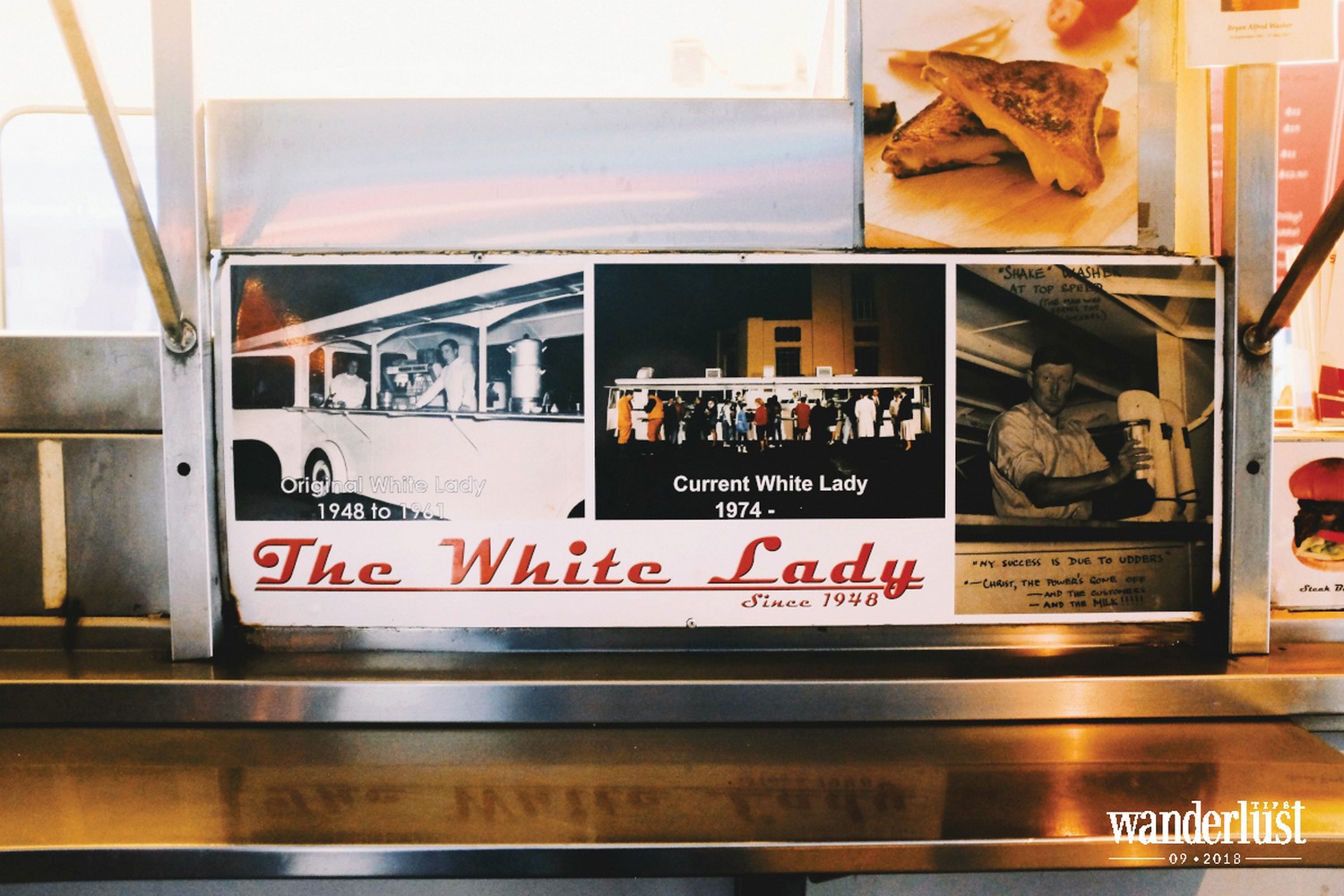
During this hard time, Pop met is future wife, Joyce. They soon got married, and the newly wedded couple went to Christchurch for the honeymoon where Pop also had ordered a new pie-cart to be made for his future business. When the honeymoon ended, returning to Auckland was not only the two love birds but also Pop’s (later legendary) pie-cart: The White Lady. According to Joyce Washer, they wanted the pie-cart to be named in a feminine way, as it was very common expression at the time to refer to an automobile as “baby” or “her”. Joyce decided to name it The White Lady because it was painted white. “There were no racial overtones in those days”, Joyce recalled.
The City Council finally agreed to grant Pop a trading license and allocated the pie-cart to be operated on Fort street, a short street which intersects Queen street – Auckland’s main street, near the Britomart Transport Centre and the Queens Wharf on the Auckland waterfront. The pie-cart had stayed there from 1950 to 2006. It was relocated due to the city’s innovation and construction. The current location of The White Lady is near the corner between Customs East Street and Commerce street which is a few hundred metres from its original location. The city has organised power and water sources for The White Lady’s operation at the spot it parked every night.
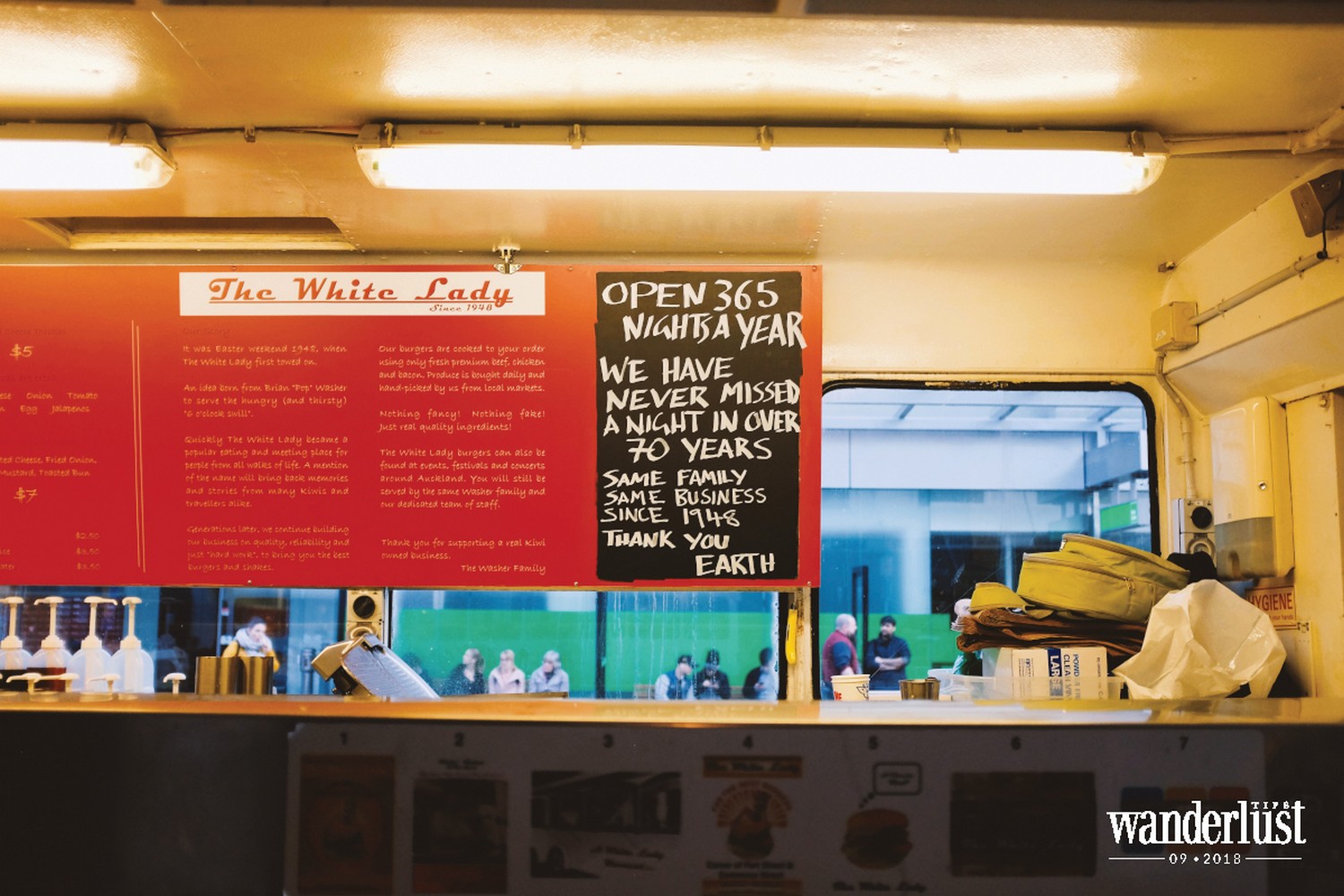
After the failure at the race tracks, with his new pie-cart, Pop Washer finally came to his success. During the 1950s and 1960s – the beginning of The White Lady, New Zealand was still seeing the effects of an alcohol restriction which had been on since the first world war in 1917. According to this restriction, all alcohol must stop being served at six o’clock every night. People called it the “six o’clock swill” to refer to the fact that most men who had worked all day went rushing into the local bars straight after work in order to enjoy their drinks before six o’clock everyday. It was way before the thrive of the café culture. Once alcoholic drinks were stopped, food premises also closed their doors. In many years before the restriction was lifted in 1967, The White Lady was the only place in Auckland CBD (central business district) that served hot meals after six o’clock. For this particular reason, the pie-cart had become a critical part of Aucklanders’ nightlife since the day it first opened.
In the beginning, Pop was operating the pie-cart since nightfall till the early next morning while Joyce was in charge of all the precooked dishes which she was making at their home – an old bach (wooden beach house) with holes on the walls in Kohimarama, an eastern suburb. Mid 20th century, food hygiene was still loose, which allowed homecooked foods to be traded commercially. Joyce recalled that besides “pea, pie, pud”, they were also selling other items like bread, egg, tomato sauce, and glasses full of chopped onion, cucumber and sliced tomato (side dish). “But no fancy serviettes. We used a communal tea towel, and the customers were all happy with that”.
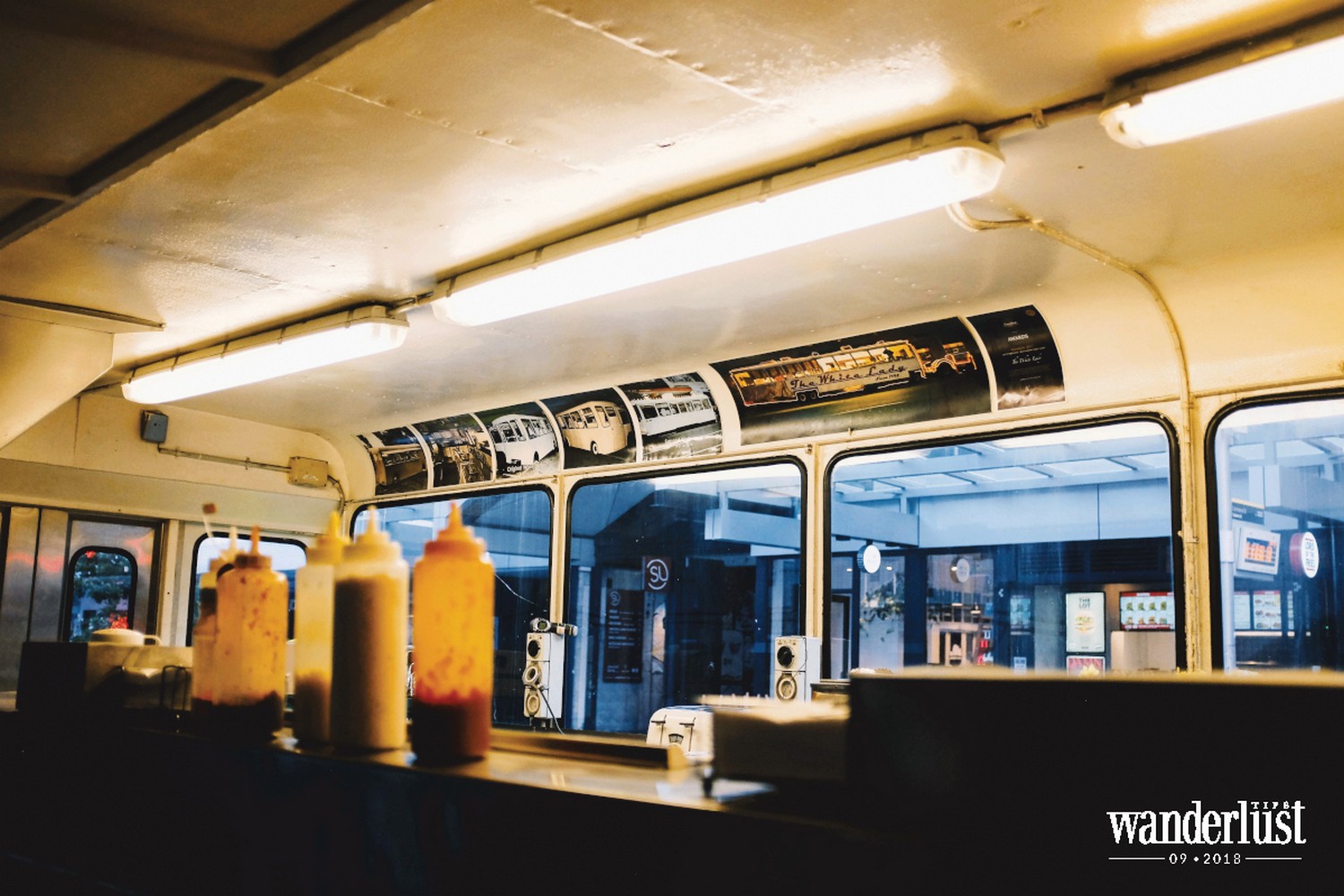
Eventually, the craving for pies of Aucklanders has faded. Nowadays, The White Lady’s menu features a list of gourmet burgers and nonalcoholic drinks. These days, food legislation is taken very seriously and all ingredients are now prepared in a professional and licensed environment, which has prohibited the existence of New Zealand’s street food culture. Street food vendors now only appear at a few weekend farmers’ markets or some annual festivals. In contrast, fast food premises can now be found everywhere. However, for some reasons, despite the fast growing fast food industry, they could not harm The White Lady. The legendary pie-cart is still there, being proud of herself as a queen of all street food vendors which have ceased to exist. The White Lady has been trading every single night in the last 70 years with the exception of one night in the summer of 1998 when a blackout affected the whole city. The power crisis put Auckland CBD in complete darkness during the nights of the next five weeks. And again, since the “six o’clock swill”, The White Lady was the only place open during this time, except for only the first night.
Nowadays, despite the effort of the city council in eliminating street food vendors like The White Lady and many of its sister pie-carts, pie-cart culture, though descending, still exists. All the surviving pie-carts are a living reminder of New Zealand’s street food culture. The White Lady’s food is anything but a disappointment, doesn’t matter if it was Joyce Washer’s “pea, pie, pud”, and steak and kidney stew made at their home during the 50s, or the current gourmet burger combining a thick freshly grilled beef patty, pieces of crispy bacon, melted fatty cheese, and crunchy lettuce. Peter Washer and his son, Max Washer, who inherited the pie-cart from his parents, ensure consistent and high quality food, which is also the utmost motto of the White Lady. Despite the fact that The White Lady is just a street food vendor, the Washers has never hesitated to price their burgers according to the quality they promise to deliver. The competing burger market in which many casual eateries and fast food chains are joining more and more every day seems to have no effect on their business philosophy. To them, it is just like what Henry Royce, one of the two founders of Rolls Royce, said, “the quality is remembered long after the price is forgotten”.
Inspite of the current upholding nightlife in Auckland with fast food chains and bars, there has never been anything as good as The White Lady’s food. The Lady and her beautiful gourmet burgers have never failed to bring joy to her customers who, for whatever reason, ever find themselves wandering the streets and habour of Auckland CBD at night. It is hard to say how long this three-generation pie-cart will still stand, but its is certain that The White Lady will go down in the culinary history of New Zealand, and of Auckland – the city of sails, land of a thousand lovers.
W.TIPS
♠ HIGHTLIGHTS
There are no indigenous mammal animals in New Zealand. There are also no snakes, lizards, or venomous spiders found in New Zealand. The indigenous animals of this island country are birds and insects. New Zealanders often refer to themselves as Kiwis, the iconic flightless bird of the country.
♠ CLIMATE
Auckland is a harbour city. It rains all year round. Light rains and drizzles are normally seen during spring and summer, while heavy rains which can last for days are common during autumn and winter. Located in the Southern Hemisphere, New Zealand’s seasons are different from the Northern Hemisphere’s. Spring starts from September to the end of November. Summer is from December to February. Autumn is from March till the end of May. June, July, and August are winter months.
♠ LANGUAGE
English is mainly used to communicate in New Zealand. However, the Māori language (te reo Māori) of the indigenous Māori people is the first de jure official language.
♠ CURRENCY
New Zealand’s currency is New Zealand dollar. NZD1 = VND15,683.3 (according to current exchange rate). Foreigner notes can be exchanged easily at many foreign exchange counters in the CBD area.
♠ TRANSPORTATION
In addition, public transportation only run till midnight. Therefore, you should arrange your schedule beforehand. You can also use many taxies around the area or Uber service (only credit card payment via Uber app is accepted).
♠ MORE INFORMATION ABOUT THE WHITE LADY
- Location: The White Lady pie-cart is located near the corner between Customs Street Eats and Commerce Street, across the road from a major bus station. If hungry, you can try the enormous burger called “The white lady” or The Aucklander burger. You should also accompany your sandwich with a can of L&P, the famous lemonade of New Zealand. Alcoholic drinks are banned in public places.
- Operating hours: The White Lady opens from 7pm from Monday to Thursday till 4 pm the next day. They open from 7pm on Friday nights to 3am on Monday mornings. You should visit the White Lady late at night to try the authentic pie-cart experience. However, from late till early morning is the busiest time at The White Lady, you are expected to wait from 15 to 20 minutes.
Wanderlust Tips

